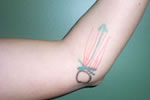| How It Happens |
A golfer’s elbow is a common term for the Medial Epicondylitis. It is the inflammation of the wrist and finger tendons that attach to the bone on the inside part of the elbow (the medial epicondyle).
Muscle and tendon overexertion causes pulling of tendon from bone. This causes micro tearing of tendons, hemorrhage, inflammation, scarring, degeneration and shortening of the tendons.
|

Black=Bone
Red=Muscle
Green=Pain |
| |
|
| Symptoms |
Pain:
There is pain and tenderness on the medial (middle) aspect of the elbow on the medial epicondyle. Usually, more severe pain can be felt during activities and there may have diffuse discomfort down the forearm and into the fingers.
Painful activities include:
- Grasping or squeezing a handle, a golf club or a tennis racquet
- Shaking hands
- Carrying a briefcase
- Writing
- Lifting objects
- Steering a car
Early Stage:
Pain after play or work.
Middle Stage:
Pain during play or work.
Last Stage:
Pain at rest and or at night.
Inflammation:
Inflammation will be present although it may not always be visible. It is the result of the irritation of the tendon and the tear of some tendon fibers.
X-Rays:
Usually nothing shows on x-ray. There may be some calcium deposit in advanced stage only. |
| |
|
| What Causes It? |
- Occupational overuse
- Weak grip strength
- Poor fitting equipment– grip size or weight of
club or racquet
- Cervical spine nerve pinching or adverse tension
- Elbow hyperextension, "double jointed"
- Overuse in a sporting or daily activity
- Improper technique
- Direct trauma
- Untreated past injury of the upper extremity
or fracture
|
| |
|
| Why Does It Hurt? |
There is either too much flexibility or too much rigidity in the foot. Both conditions result in localized inflammation at the heel that is "squeezed out" with weight bearing.
At night or rest, inflammation in absorbed into the area, pushing on sensitive nerve endings. The first morning steps are very painful and stiff until the inflammation is squeezed out and scar tissue is stretched. Once the inflammation and scarring are present they are difficult to remove. The longer the condition runs its course without intervention, the more difficult it is to rehabilitate. |
| |
|
| What Should You Do? |
- Rest from painful activities
- Icing will help decrease the inflammation and the pain
- Analyze and correct your technique in sporting or occupational
activities
- Make sure you stretch properly before and after each activity
- Compressive bracing prevents tendon pulling from bone and absorbs
vibration
- Have an expert look at your equipment and change it if required
|
| |
| How Do I Prevent It? |
- Avoid overuse by gradually increasing in intensity and frequency
of play/activity
- Avoid technique and equipment errors
- Maintain flexibility and strength of forearm muscles
- Maintain mobility of potentially restrictive structures
- Many cases should be able to return to activity without a brace, a
brace may be used on initial stages of returning to the aggravating
activity
|
| |
| Will Physiotherapy Help Me? |
A physiotherapist will assess your condition and determine the origin of your pain. Your treatment plan will address both the local symptoms such as pain and inflammation as well as the cause of your pain (see causes above).
If you have developed this problem through a specific activity, your physiotherapist can review your technique and make recommendations to avoid injury.
You will also be given an exercise program that will include proper stretching and strengthening exercises, to maintain the flexibility and strength of the wrist, elbow and shoulder muscles. With the help of modalities, physiotherapy will reduce your symptoms and promote healing.
|

